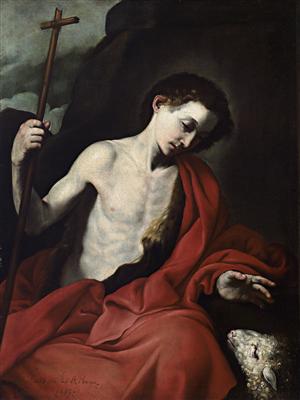Jusepe de Ribera (Jativa 1591 – 1652 Naples)

Saint John the Baptist, signed and dated at lower left: Jusepe de Ribera/1632, oil on canvas, 109.3 x 82.3 cm, framed
Provenance:
European private collection
Literature:
N. Spinosa, Ribera. L’opera completa, Naples 2006, p.311, cat. n. A138
The present composition displays a stylistic change in Ribera’s oeuvre in the first years of the 1630s, when he moved away from the realism of his early years in Naples and began to execute paintings characterized by a light palette and loose brushwork. His works from this period are characterized by a Baroque sensitivity together with a refined sensibility towards colour. The present painting still shows characteristics of a strong naturalism, such as in the depiction of the head of the lamb as well as the thin body of Saint John the Baptist, which is strongly lit, whilst other elements reveal his stylistic transformation towards a more pictorial manner.
Throughout his career, Ribera executed various paintings showing Saint John the Baptist in the desert, a subject which was also several times reworked by Caravaggio, who created new iconographic models.
Ribera chose a closer view of the composition for the present painting compared to the full-length figures known through other works, as for example the Saint John the Baptist of 1638 (Madrid, Real Monastero de la Encarnacio; see Spinosa, op. cit., p. 344, no. A237). A similar composition and the luminous landscape in the background appear in other paintings from the end of the thirties, as the Saint John the Baptist conserved in Valladolid (Palacio de Ayuntamiento, see Spinosa, op. cit., p. 291, no. A78), which critics also date to the 1630s.
The young Saint John the Baptist is shown in three quarters, with his figure is set before a rocky background. He leans towards the lamb, his hand outstretched and tense in expectation of touch. In his right hand he hold a cross made of reed. Even if the scene is a prefiguration of the saint’s destiny to be sacrificed as the precursor of Christ, he seems to find himself in a moment of unburdened acceptance, which his meditating and calm pose as well as his serene expression appear to testify.
17.10.2012 - 18:00
- Dosažená cena: **
-
EUR 317.500,-
- Odhadní cena:
-
EUR 100.000,- do EUR 150.000,-
Jusepe de Ribera (Jativa 1591 – 1652 Naples)
Saint John the Baptist, signed and dated at lower left: Jusepe de Ribera/1632, oil on canvas, 109.3 x 82.3 cm, framed
Provenance:
European private collection
Literature:
N. Spinosa, Ribera. L’opera completa, Naples 2006, p.311, cat. n. A138
The present composition displays a stylistic change in Ribera’s oeuvre in the first years of the 1630s, when he moved away from the realism of his early years in Naples and began to execute paintings characterized by a light palette and loose brushwork. His works from this period are characterized by a Baroque sensitivity together with a refined sensibility towards colour. The present painting still shows characteristics of a strong naturalism, such as in the depiction of the head of the lamb as well as the thin body of Saint John the Baptist, which is strongly lit, whilst other elements reveal his stylistic transformation towards a more pictorial manner.
Throughout his career, Ribera executed various paintings showing Saint John the Baptist in the desert, a subject which was also several times reworked by Caravaggio, who created new iconographic models.
Ribera chose a closer view of the composition for the present painting compared to the full-length figures known through other works, as for example the Saint John the Baptist of 1638 (Madrid, Real Monastero de la Encarnacio; see Spinosa, op. cit., p. 344, no. A237). A similar composition and the luminous landscape in the background appear in other paintings from the end of the thirties, as the Saint John the Baptist conserved in Valladolid (Palacio de Ayuntamiento, see Spinosa, op. cit., p. 291, no. A78), which critics also date to the 1630s.
The young Saint John the Baptist is shown in three quarters, with his figure is set before a rocky background. He leans towards the lamb, his hand outstretched and tense in expectation of touch. In his right hand he hold a cross made of reed. Even if the scene is a prefiguration of the saint’s destiny to be sacrificed as the precursor of Christ, he seems to find himself in a moment of unburdened acceptance, which his meditating and calm pose as well as his serene expression appear to testify.
|
Horká linka kupujících
Po-Pá: 10.00 - 17.00
old.masters@dorotheum.at +43 1 515 60 403 |
| Aukce: | Obrazy starých mistr? |
| Typ aukce: | Salónní aukce |
| Datum: | 17.10.2012 - 18:00 |
| Místo konání aukce: | Wien | Palais Dorotheum |
| Prohlídka: | 06.10. - 17.10.2012 |
** Kupní cena vč. poplatku kupujícího a DPH
Není již možné podávat příkazy ke koupi přes internet. Aukce se právě připravuje resp. byla již uskutečněna.
Další objekty umělce
-

Jusepe de Ribera, called lo Spagnoletto
Odhadní cena:
EUR 600.000,- do EUR 800.000,-
Všechny objekty umělce
Položky z jiných aukcí
- Römische Schule, um 1625
- 2012 Steinzeiler, Weingut Kollwentz, Burgenland, 93 Falstaff-Punkte, 27 Flaschen
- ** - Österr. - BLITZ/TOTENKOPF- laut
- Poststück/Briefstück - Partie Poststücke Österr. ab 1945 mit FDCs,
- Poststück - Österr. Feldpost WK I - Partie Luftwaffe - Fliegende Einheiten und Bodeneinheiten,
